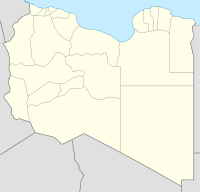Sabrata
|
Sabratha صبراتة |
||
|---|---|---|
 |
||
|
||
| Location in Libya | ||
| Coordinates: 32°47′32″N 12°29′3″E / 32.79222°N 12.48417°E | ||
| Country | Libya | |
| Region | Tripolitania | |
| District | Zawiya | |
| Elevation | 30 ft (10 m) | |
| Population (2004) | ||
| • Total | 102,038 | |
| Time zone | EET (UTC+2) | |
| Website | sabratha.gov.ly | |
| Archaeological Site of Sabratha | |
|---|---|
| Name as inscribed on the World Heritage List | |

|
|
| Location | Libya |
| Type | Cultural |
| Criteria | iii |
| Reference | 184 |
| UNESCO region | Arab States |
| Inscription history | |
| Inscription | 1982 (6th Session) |
Sabratha, Sabratah or Siburata (Arabic: صبراتة), in the Zawiya District of Libya, was the westernmost of the ancient "three cities" of Roman Tripolis. From 2001 to 2007 it was the capital of the former Sabratha wa Sorman District. It lies on the Mediterranean coast about 70 km (43 mi) west of modern Tripoli. The extant archaeological site was inscribed as a UNESCO World Heritage Site in 1982.
Sabratha's port was established, perhaps about 500 BC, as a Phoenician trading-post that served as a coastal outlet for the products of the African hinterland. The Phoenicians gave it the Lybico-Berber name 'Sbrt'n', which suggests that there may have been a native settlement built there prior to the Phoenicians' arrival. Sabratha became part of the short-lived Numidian Kingdom of Massinissa before being Romanized and rebuilt in the 2nd and 3rd centuries AD. The Emperor Septimius Severus was born nearby in Leptis Magna, and Sabratha reached its monumental peak during the rule of the Severans. The city was badly damaged by earthquakes during the 4th century, particularly the quake of AD 365. It was rebuilt on a more modest scale by Byzantine governors. The town was site of a bishopric. Within a hundred years of the Arab conquest of the Maghreb, trade had shifted to other ports and Sabratha dwindled to a village.
Due to soft soil composition and the nature of the Coast of Sabratha being mostly made up of soft rock and sand, the Ruins of Sabratha are undergoing dangerous periods of coastal erosion. The public baths, Olive Press building and 'Harbor' can be observed as being most damaged as the buildings have crumbled due to storms and unsettled seas.
...
Wikipedia


